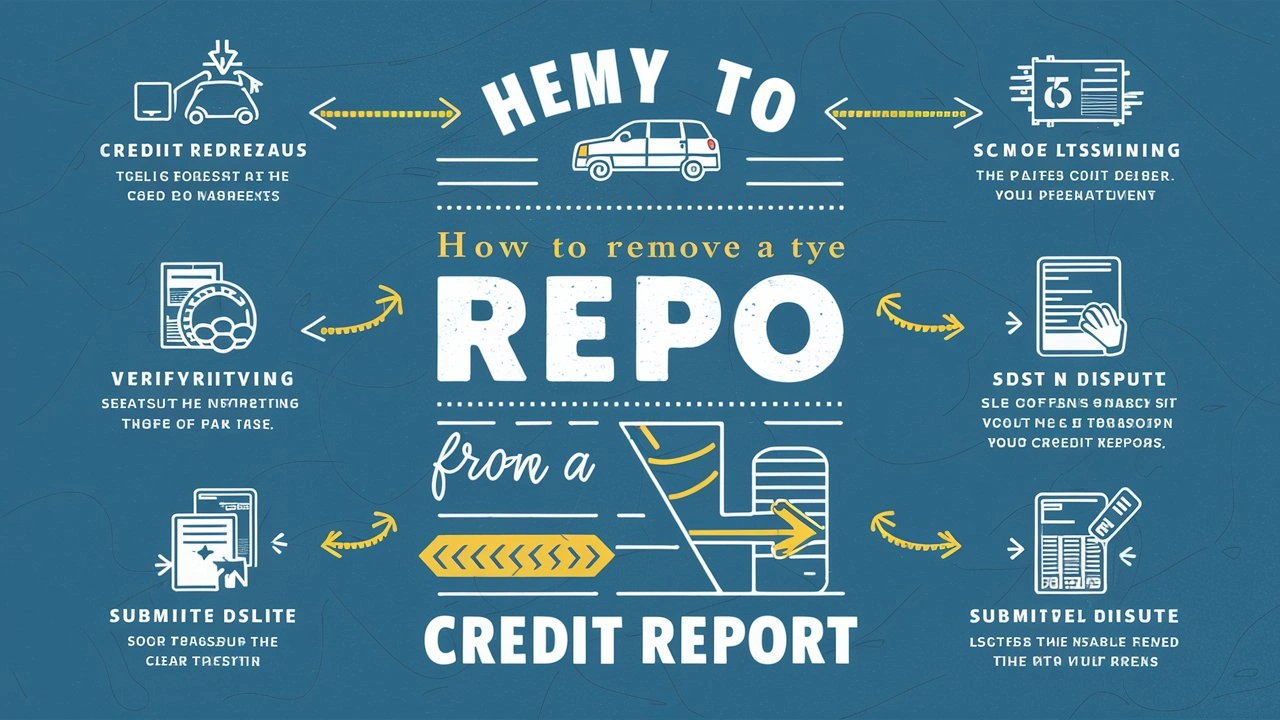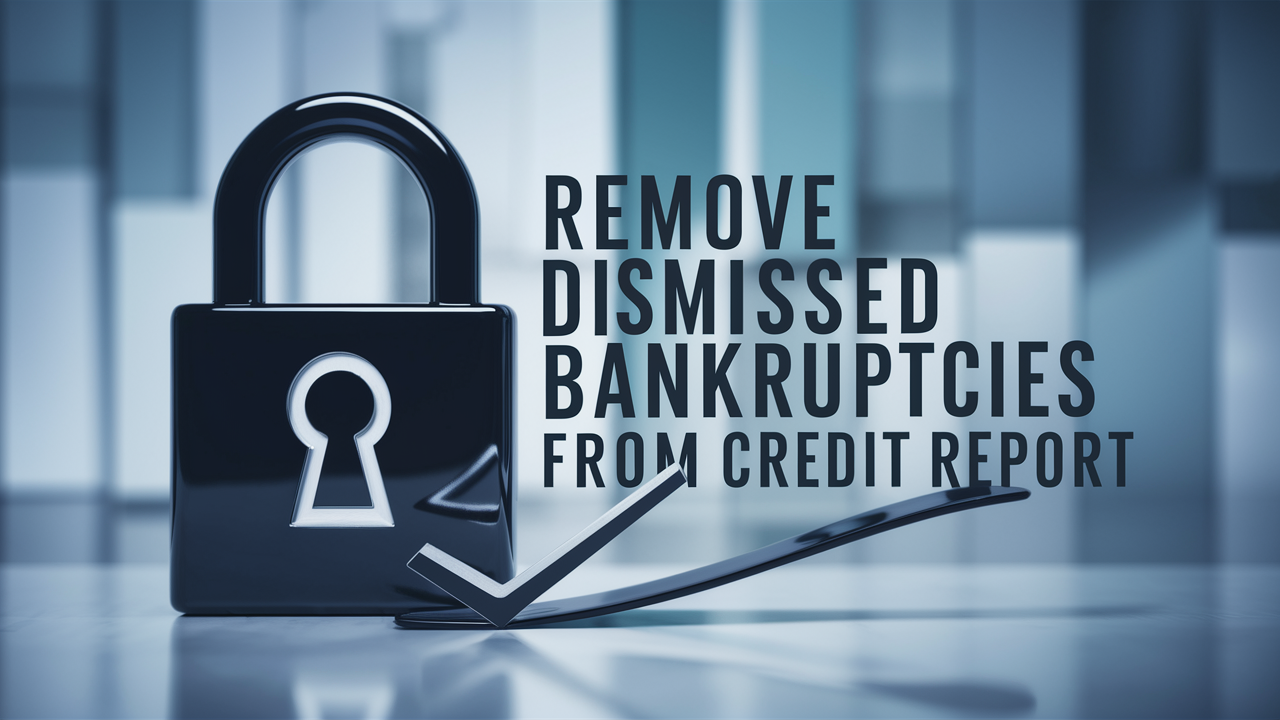How To Remove A Repo From Credit?

Understanding how to remove a repossession from your credit report is crucial for regaining financial health. This guide provides a comprehensive, step-by-step approach to challenging inaccurate repossessions and improving your credit score, empowering you with the knowledge to take control of your financial future.
Understanding Repossession and Its Credit Impact
A vehicle repossession, or any other asset repossession, is a serious financial event that significantly impacts your creditworthiness. When you fail to make payments on a secured loan (like a car loan or mortgage), the lender has the legal right to seize the asset to recoup their losses. This act is recorded on your credit report and can remain there for up to seven years, according to the Fair Credit Reporting Act (FCRA). The presence of a repossession can lead to higher interest rates on future loans, difficulty obtaining new credit, and even challenges in renting an apartment or securing certain types of employment. In 2025, the average credit score in the U.S. hovers around 715, but a repossession can easily drop this score by 100 points or more, making it a substantial hurdle for financial stability. Understanding the mechanics of how a repossession affects your credit is the first step toward mitigating its damage.
What is a Repossession?
A repossession occurs when a lender takes back a property that was used as collateral for a loan because the borrower has defaulted on their payments. This typically applies to loans where the asset itself secures the debt, such as auto loans, mortgages, and loans for recreational vehicles. The process is initiated after a borrower falls behind on payments and often involves a grace period or notice from the lender before the seizure takes place. The lender then typically sells the asset at auction to recover the outstanding loan balance. If the sale price is less than the amount owed, the borrower may still be liable for the deficiency balance, which can also be reported to credit bureaus.
The Long-Term Effects on Your Credit Score
The negative impact of a repossession on a credit score is substantial and long-lasting. A repossession is considered a severe delinquency and is treated as such by credit scoring models. As of 2025, FICO and VantageScore, the two primary credit scoring systems, heavily penalize such negative marks. A single repossession can reduce a credit score by as much as 100-150 points, depending on the score range and the borrower's credit history prior to the event. This dramatic drop can push a score from "good" to "poor" or "fair" almost instantly. The damage isn't just immediate; it lingers for the full seven-year reporting period. This prolonged negative presence makes it challenging to achieve favorable terms on new credit, such as lower interest rates on mortgages, auto loans, or credit cards. In some cases, it can even affect insurance premiums, as insurers may view individuals with a history of repossession as higher risk.
Repossession vs. Foreclosure
While both repossession and foreclosure are serious consequences of loan default, they apply to different types of assets and have distinct processes. Repossession specifically refers to the seizure of personal property, most commonly a vehicle, used as collateral for a loan. Foreclosure, on the other hand, is the legal process by which a lender reclaims real estate (like a house) when the borrower fails to make mortgage payments. Both events are severe negative marks on a credit report, but foreclosures often carry even greater weight due to the higher value of the asset and the more complex legal proceedings involved. The reporting period for both is typically seven years from the date of the delinquency that led to the action.
Legal Grounds for Removing a Repossession
While a repossession itself is a legitimate event if you defaulted on a loan, there are specific legal grounds and procedural errors that can allow you to challenge its accuracy and potentially have it removed from your credit report. Understanding these grounds is key to building a strong case for removal. The primary avenue for removal lies in proving that the repossession was reported inaccurately or that the lender did not follow proper legal procedures.
Inaccurate Reporting by the Lender
Credit bureaus and lenders are obligated to report information accurately. If the repossession was reported incorrectly, you have grounds for dispute. This can include:
- Incorrect Dates: The date of the repossession or the date of the delinquency leading to it might be wrong. This can affect how long the item stays on your report and its impact on your score.
- Wrong Asset: The report might indicate a repossession of an asset you never owned or that was not collateral for the loan in question.
- Incorrect Amount Owed: The reported balance after the sale of the asset (deficiency balance) could be inaccurate.
- Duplicate Reporting: The same repossession may have been reported by multiple entities or multiple times.
Procedural Errors by the Lender
Lenders must adhere to strict legal procedures before and after repossessing an asset. Failure to comply with these procedures can invalidate the repossession or provide grounds for its removal from your credit report. Common procedural errors include:
- Improper Notice: In many states, lenders are required to provide specific written notice to borrowers before repossessing an asset. If this notice was not sent or was sent incorrectly, the repossession may be considered unlawful.
- Breach of the Peace: Lenders are not allowed to commit a "breach of the peace" during repossession. This generally means they cannot use force, threats, or enter your private property (like a locked garage) without permission. If the repossession was conducted illegally, it could be grounds for dispute.
- Improper Sale of the Asset: After repossessing the asset, the lender must typically sell it in a "commercially reasonable manner." This means they cannot sell it for a drastically undervalued price, such as at a private sale to a friend for pennies on the dollar. The sale must be conducted fairly to maximize the recovery amount.
- Failure to Provide a Deficiency Notice: If the sale of the asset did not cover the full loan balance, the lender may seek a deficiency judgment. In many jurisdictions, they must provide you with notice of the sale and the intent to pursue a deficiency balance. Failure to do so can impact their ability to collect the deficiency and may be grounds for disputing the reporting.
Statute of Limitations
While a repossession can remain on your credit report for seven years, the statute of limitations for collecting on the debt (especially a deficiency balance) is different and varies by state. If the lender attempts to collect a deficiency balance after the statute of limitations has expired, it is illegal. While this doesn't automatically remove the repossession from your credit report, it can be a powerful negotiating tool and a basis for a dispute if the lender is still reporting the deficiency incorrectly.
Settlement Agreements
Sometimes, a lender may agree to remove a negative mark from your credit report as part of a settlement. This is more common if you can demonstrate a clear error or if you are offering a lump-sum payment to settle a debt. However, such agreements should always be in writing and clearly state that the negative item will be removed from your credit report in exchange for your payment or agreement. This is often referred to as a "pay-for-delete" agreement, though it's not always explicitly called that.
The Step-by-Step Process to Remove a Repossession
Removing a repossession from your credit report requires a systematic and persistent approach. It involves gathering evidence, communicating effectively with credit bureaus and lenders, and understanding your rights. By following these steps diligently, you can significantly increase your chances of a successful removal.
Step 1: Obtain Your Credit Reports
The first and most crucial step is to get copies of your credit reports from all three major credit bureaus: Equifax, Experian, and TransUnion. You are entitled to a free credit report from each bureau annually through AnnualCreditReport.com. Review each report meticulously for any mention of a repossession. Note the exact details: the date, the creditor, the amount, and any associated remarks. Ensure you have the most up-to-date information, as reports can vary slightly between bureaus.
Step 2: Gather All Relevant Documentation
Collect any and all documents related to the loan and the repossession. This includes:
- The original loan agreement.
- All payment records and statements.
- Any correspondence with the lender regarding late payments or the repossession itself (letters, emails, notes from phone calls).
- The notice of sale or sale bill from the auction.
- Proof of insurance at the time of repossession (if applicable).
- Any documents showing payments made after the repossession, if any.
- Evidence of any procedural errors (e.g., proof that notice was not received).
The more documentation you have, the stronger your case will be.
Step 3: Determine the Basis for Your Dispute
Based on your review of your credit reports and gathered documentation, identify why you believe the repossession is inaccurate or should be removed. Common reasons include:
- The repossession is not yours.
- The repossession date or amount is incorrect.
- The lender failed to follow proper legal procedures (e.g., improper notice, breach of peace).
- The item was not collateral for the loan.
- The debt has been paid in full, but the repossession is still reported.
- The repossession was a result of identity theft.
Step 4: Send a Dispute Letter to the Credit Bureaus
You must formally dispute the inaccurate information with each credit bureau that is reporting the repossession. Draft a dispute letter for each bureau. Your letter should:
- Clearly state your name, address, and account number (if available).
- Identify the specific item you are disputing (the repossession).
- Explain precisely why you believe the information is inaccurate or should be removed, referencing the legal grounds you've identified.
- Attach copies (never originals) of all supporting documentation.
- Request that the inaccurate information be investigated and removed from your credit report.
- Include a return address and date.
Send the letters via certified mail with a return receipt requested. This provides proof that the credit bureau received your dispute. The credit bureaus have 30 days (or 45 days if you submit new information during the 30-day period) to investigate your dispute. They will typically contact the furnisher of the information (the lender) to verify its accuracy.
Step 5: Send a Debt Validation Letter to the Lender (Optional but Recommended)
While disputing with the credit bureaus, you can also send a debt validation letter to the original lender or debt collector. This letter, sent within 30 days of receiving initial communication about the debt, requests that they provide proof that they legally own the debt and that the amount is accurate. If they cannot validate the debt, they are legally obligated to stop collection efforts and cannot report it to credit bureaus. This can be a powerful tool, especially if the debt has been sold to a third-party collector.
Step 6: Follow Up and Escalate
If the credit bureaus do not remove the repossession after their investigation, or if they claim it is accurate, review their findings. If you believe their investigation was inadequate or if you have new evidence, you can send a follow-up letter. You can also file a complaint with the Consumer Financial Protection Bureau (CFPB) or your state Attorney General's office. If the lender has violated your rights, you may need to consider legal action.
Step 7: Negotiate with the Lender (If Applicable)
In some cases, especially if the repossession is accurate but you wish to mitigate its impact, negotiation might be an option. This could involve offering a lump-sum payment to settle the deficiency balance in exchange for a goodwill gesture or agreement to update the reporting. However, this is often more effective before the item is reported or if you are dealing with a collection agency. Always get any agreement in writing.
Negotiating with Creditors and Lenders
Negotiation can be a powerful strategy when dealing with a repossession, whether you're trying to prevent it, settle a deficiency balance, or even negotiate its removal from your credit report. While lenders are often rigid, understanding their motivations and your leverage can lead to favorable outcomes. Negotiation is not always about getting the repossession removed entirely but can be about mitigating its financial impact and improving its reporting.
When to Negotiate
Negotiation can be attempted at several stages:
- Before Repossession: If you anticipate difficulty making payments, contact your lender immediately. They may be willing to work out a payment plan, deferment, or loan modification to avoid the costly process of repossession.
- After Repossession, Before Sale: If the asset has been repossessed but not yet sold, you might be able to negotiate to buy it back or arrange for its sale to a third party, potentially avoiding a deficiency balance.
- After Sale, Regarding Deficiency: If there is a deficiency balance owed, negotiation is most common here. You can try to settle the debt for a lower amount.
- With Credit Bureaus/Lenders for Removal: In cases of clear errors or significant procedural missteps, you can negotiate for the removal of the item from your credit report, often as part of a settlement.
Strategies for Effective Negotiation
To maximize your chances of a successful negotiation:
- Be Prepared: Know your financial situation inside and out. Have documentation ready to support your claims and your proposed solutions.
- Be Polite and Professional: Even though you're in a difficult situation, maintaining a respectful tone can go a long way.
- Understand Their Position: Lenders want to recover as much of their money as possible with minimal effort. Presenting a solution that benefits them (e.g., a guaranteed lump sum payment) can be persuasive.
- Know Your Rights: Familiarize yourself with state and federal laws regarding repossession and debt collection. This knowledge can be a powerful negotiating tool.
- Focus on Solutions: Instead of just stating the problem, propose concrete solutions. For example, "I can offer a lump sum of $X to settle this deficiency balance," or "I believe the repossession was reported incorrectly because [reason], and I request its removal."
- Get Everything in Writing: This is paramount. Any agreement reached, especially one involving debt settlement or credit reporting changes, must be documented in a written contract signed by both parties before you make any payments or take any action.
Negotiating a Deficiency Balance
A deficiency balance is the amount still owed after the repossessed asset is sold. Negotiating this balance can significantly reduce your financial burden. You can often negotiate a lower lump-sum payment to settle the debt. For example, if you owe a $5,000 deficiency, you might be able to settle for $3,000. This saves the lender collection costs and provides you with a clear end to the obligation. Remember, settling for less than the full amount may still be reported as a settled debt, but it's often better than an unpaid deficiency.
"Pay-for-Delete" Agreements
This is a highly sought-after, though not always achievable, negotiation outcome. A "pay-for-delete" agreement is when a creditor or collection agency agrees to remove a negative item from your credit report entirely in exchange for payment. These agreements are more common with third-party debt collectors than with original creditors. It's crucial to get this agreement in writing before making any payment. Many collectors will not offer this upfront, and you may need to be persistent and articulate your case for why removal is warranted (e.g., disputing accuracy, significant hardship).
Important Note: While "pay-for-delete" can be very beneficial, it's not guaranteed. Lenders and collectors may not be willing to agree to it. If they agree to remove the item, ensure it's explicitly stated in your written agreement.
Disputing Inaccuracies
The core of removing a repossession from your credit report often lies in identifying and disputing inaccuracies. The Fair Credit Reporting Act (FCRA) mandates that credit bureaus and furnishers of information investigate disputes within a reasonable period, typically 30 days. If they cannot verify the accuracy of the disputed information, it must be removed. This section delves deeper into the types of inaccuracies and how to effectively dispute them.
Common Types of Inaccuracies to Look For
Beyond the basic details, several subtle inaccuracies can occur:
- Identity Theft: If the repossession is on your report but you never owned the vehicle or took out the loan, it could be a sign of identity theft. You'll need to file a police report and an FTC affidavit.
- Incorrect Ownership: The repossession might be linked to a vehicle you sold or traded in years prior, and the new owner defaulted.
- Incorrect Loan Terms: The reported loan balance, interest rate, or payment history might be misstated, affecting the perceived severity of the default.
- Outdated Information: While repossessions are typically removed after seven years, sometimes they are incorrectly kept on the report longer.
- Reporting of Unsettled Debt After Settlement: If you settled a deficiency balance, but the report still shows it as unpaid or delinquent, that's an inaccuracy.
The Dispute Process in Detail
The dispute process is a formal procedure governed by the FCRA. Here's a breakdown:
- Initial Review: Obtain your credit reports from all three bureaus and carefully examine the repossession entry.
- Gather Evidence: Collect all documents that support your claim of inaccuracy. This is critical. For example, if the date is wrong, provide proof of when you sold the vehicle or made your last payment.
- Draft Your Dispute Letter: For each credit bureau reporting the inaccuracy, send a separate dispute letter.
- Address: Use the dispute address provided by each credit bureau (usually found on their website or your credit report).
- Content:
- Your full name, address, and Social Security number.
- The specific account number associated with the repossession.
- The exact item you are disputing (e.g., "Repossession of [Vehicle Year, Make, Model] reported by [Lender Name]").
- A clear and concise explanation of why the information is inaccurate, referencing specific details and dates.
- A list of enclosed documents (e.g., "Enclosed: Copy of bill of sale dated [Date]").
- A request for investigation and removal of the inaccurate information.
- Your signature and date.
- Supporting Documents: Include copies of your evidence. Never send originals.
- Send via Certified Mail: Always send your dispute letters via certified mail with a return receipt requested. This provides undeniable proof of delivery and the date it was received.
- Credit Bureau Investigation: Upon receiving your dispute, the credit bureau must investigate. They will typically forward your dispute and evidence to the lender (the furnisher of information) for verification.
- Furnisher's Response: The lender has a limited time to respond to the credit bureau's inquiry. They must provide evidence to support the accuracy of the information.
- Credit Bureau's Decision: Based on the investigation and the furnisher's response, the credit bureau will update your report or inform you that the information is accurate.
- Follow-Up: If the item is not removed and you believe the investigation was flawed, you can send a follow-up letter with additional evidence. You can also file a complaint with the CFPB.
What If the Lender Verifies the Information?
If the lender verifies the repossession and the credit bureau upholds its accuracy, it can be disheartening. However, this doesn't mean you're out of options. You can:
- Re-dispute with New Evidence: If you find more documentation or a new angle, you can dispute again.
- Contact the Lender Directly: Sometimes, a direct conversation with the lender or their internal dispute resolution department can be more productive than going through the credit bureaus.
- Consider Legal Action: If you are certain the information is inaccurate and the credit bureaus and lender have failed to correct it, consulting an attorney specializing in consumer law might be necessary.
- Negotiate a Settlement: If the repossession is accurate, focus on negotiating its removal or a more favorable reporting status.
The Role of the Consumer Financial Protection Bureau (CFPB)
The CFPB is a federal agency that protects consumers in the financial sector. If you believe a credit bureau or lender has violated your rights under the FCRA or other consumer protection laws, you can file a complaint with the CFPB. The CFPB will forward your complaint to the company involved and work to get a response. While the CFPB doesn't represent individual consumers in court, their actions can lead to investigations and enforcement actions against companies with patterns of misconduct. Filing a complaint can also sometimes prompt the company to review your case more thoroughly.
When to Seek Professional Help
While many individuals can successfully navigate the process of removing a repossession from their credit report independently, there are situations where professional assistance is highly beneficial, or even necessary. Professionals have specialized knowledge, experience, and resources that can significantly improve your chances of success.
credit repair companies
Credit repair companies specialize in helping individuals improve their credit reports. They can assist with:
- Identifying Errors: They are skilled at spotting inaccuracies that the average consumer might miss.
- Disputing Information: They know the proper procedures and language to use when disputing items with credit bureaus and furnishers.
- Negotiating with Creditors: Many have established relationships and negotiation tactics that can be effective.
- Saving Time: They handle the administrative burden of disputes, allowing you to focus on other financial priorities.
Important Considerations:
- Choose Wisely: Research companies thoroughly. Look for established companies with good reviews and transparent fee structures. Be wary of companies that guarantee results or charge high upfront fees.
- Understand Their Role: Credit repair companies cannot legally remove accurate information from your credit report. Their success relies on identifying and disputing inaccuracies or negotiating removals.
- Cost: Most credit repair services charge a monthly fee, which can range from $50 to $150 or more. Ensure the cost is justified by the potential benefits.
Consumer Protection Attorneys
If you suspect significant legal violations by the lender or credit bureau, or if your attempts to resolve the issue independently have failed, consulting a consumer protection attorney is advisable. These attorneys specialize in laws like the FCRA, the Fair Debt Collection Practices Act (FDCPA), and state consumer protection statutes. They can help if:
- The Repossession Was Illegal: If the lender breached the peace, failed to provide proper notice, or engaged in other illegal practices.
- The Credit Bureau or Lender Ignored Your Rights: If they failed to investigate your disputes properly or continued to report inaccurate information after being notified.
- You Are Facing Lawsuits: If the lender is suing you for a deficiency balance, an attorney can represent you.
- You Want to Pursue Damages: In cases of severe violations, an attorney can help you seek compensation for damages caused by the inaccurate reporting.
Important Considerations:
- Fees: Attorney fees can vary. Some work on contingency, meaning they only get paid if you win a settlement or judgment. Others charge hourly rates.
- Legal Expertise: An attorney provides a level of expertise and legal recourse that credit repair companies cannot match.
When Professional Help is Most Crucial
Seek professional help if:
- You've Tried for Months Without Success: If your own dispute letters have been ignored or denied without proper investigation.
- The Repossession is Complex: Involving multiple lenders, debt collectors, or a long history of misreporting.
- You Suspect Identity Theft or Fraud: Especially if the repossession is completely unrelated to your financial activities.
- You Received Legal Threats: Such as a lawsuit for a deficiency balance.
- You Feel Overwhelmed: The process can be emotionally and financially draining. A professional can alleviate some of that stress.
Choosing the right professional depends on your specific situation and the severity of the issue. For most straightforward inaccuracies, a reputable credit repair company might suffice. For more serious legal violations or complex cases, an attorney is often the best path forward.
Preventing Future Repossession
While removing a past repossession is a critical step, the best long-term strategy is to prevent future ones. This involves proactive financial management, open communication with lenders, and building a stable financial foundation. By implementing these practices, you can avoid the devastating consequences of repossession and maintain a healthy credit profile.
Maintain a Budget and Track Expenses
A clear understanding of your income and expenses is fundamental. Create a detailed budget that accounts for all your spending. Regularly review your budget to identify areas where you can cut back and allocate more funds towards loan payments. Tools like budgeting apps, spreadsheets, or even a simple notebook can help you stay on track. By knowing where your money is going, you can ensure that loan payments are prioritized.
Build an Emergency Fund
An emergency fund is your financial safety net. Aim to save at least 3-6 months' worth of essential living expenses. This fund can cover unexpected costs like medical bills, job loss, or significant home repairs without forcing you to miss loan payments. Having this buffer significantly reduces the risk of default and subsequent repossession.
Communicate with Your Lender Proactively
If you foresee any difficulty in making a loan payment, do not wait until you are delinquent. Contact your lender immediately. Explain your situation honestly and ask about potential solutions. Lenders are often more willing to work with borrowers who communicate proactively. They may offer options such as:
- Temporary Forbearance: Pausing payments for a short period.
- Payment Deferral: Adding missed payments to the end of the loan term.
- Modified Payment Plan: Adjusting your monthly payment amount.
- Loan Modification: Changing the terms of the loan to make it more manageable.
Early communication can prevent a minor issue from escalating into a full-blown repossession.
Avoid Taking on Unmanageable Debt
Before taking out a new loan, especially for a large purchase like a vehicle or home, carefully assess your ability to afford the monthly payments, insurance, maintenance, and other associated costs. Consider the total cost of ownership, not just the sticker price or monthly payment. If a loan payment would strain your budget or require you to sacrifice other essential financial goals, it might be too much debt to take on at this time.
Consider Loan Protection Insurance
For certain loans, like auto loans, you might consider optional loan protection insurance. This type of insurance can cover your loan payments for a specific period if you experience involuntary unemployment, disability, or death. While it comes at an additional cost, it can provide invaluable peace of mind and protection against repossession in unforeseen circumstances.
Review Your Credit Regularly
Continue to monitor your credit reports regularly. This allows you to catch any emerging inaccuracies or potential issues early on. By staying informed about your credit health, you can take timely corrective actions and maintain a strong financial standing.
Conclusion
Navigating the process of removing a repossession from your credit report demands diligence, patience, and a thorough understanding of your rights. By meticulously gathering documentation, crafting clear dispute letters, and persistently following up with credit bureaus and lenders, you can significantly improve your chances of rectifying inaccuracies. Remember that legal grounds for removal often stem from procedural errors by the lender or outright inaccuracies in reporting. If direct negotiation with creditors proves challenging, or if the situation involves complex legal violations, seeking assistance from credit repair professionals or consumer protection attorneys can provide invaluable expertise and support. Ultimately, the goal is not just to remove the negative mark but to rebuild your creditworthiness and prevent future financial setbacks. Proactive budgeting, maintaining an emergency fund, and open communication with lenders are crucial steps in safeguarding your financial future and ensuring that a repossession remains a past challenge, not a recurring problem.
Related Stories
Recent Posts
Does Closing a Checking Account Affect Your Credit Score? Here’s the Truth
Is a Home Equity Loan a Second Mortgage? The Definitive 2025 Guide
Which Credit Score is Most Accurate? FICO vs VantageScore
Does Closing a Checking Account Affect Credit Score? – Complete Guide for Consumers
Credit Captain Reviews (2025): Is It Legit, Safe, and Worth It?



